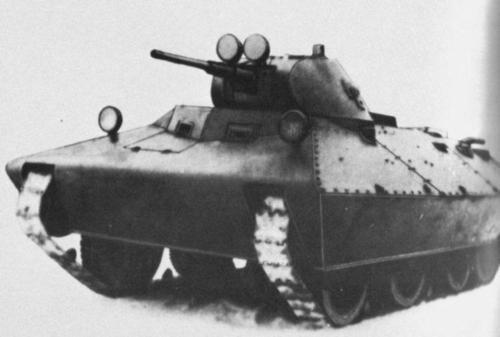
In 1936 the design bureau at Zavod Nr. 183in Kharkov built the sleek BT-SV-2 prototype which was the culmilation of their studies on improving the balistic qualities of the Betuska (BT tank).
A BT-2 during the battle of Moscow, winter 1941/42.
T-28M (or T-28E) of the 1st “Red Banner” Tank Division, 1st Mechanized Corps, Karelian Front, June 1941.
Following experience gained in the Spanish Civil War, the BT-7’s armor was increased, and it received a new engine. The resulting BT-7M medium tank, also known as the BT-8, was produced only in limited numbers. The hull was modified and included a new fullwidth, well-sloped front glacis plate instead of the faired nose of the earlier BT series. The BT-7M also mounted a 76mm gun and two machine guns.
BT-7 tanks played a key role in the Soviet victory against the Japanese in the Battle of Nomonhan/Khalkhin Gol during May–September 1939. BT variants included command tanks, bridge-laying tanks, and a few flamethrower tanks. The BT-7 was certainly the most important Soviet tank in September 1939.
The final BT-series tank, the BT-1S, appeared in prototype only. Employing sloping side armor and glacis, the BT-1S also had removable side skirts. The first Soviet tank with all-sloping armor, it was an important step forward to the T-34.
The first indigenous Soviet medium tank design, the T-28, incorporated multiple turrets and was intended for an independent breakthrough role. Inspired by the Vickers A6 (its suspension was a clear copy) and German Grosstraktor designs, it grew out of the 1932 Red Army mechanization plan and was first produced by the Leningrad Kirov Plant. Intended for an attack role, the T-28 had a central main gun turret and two machine-gun turrets in front and to either side. The T-28 weighed 28,560 pounds, had a six-man crew, and was powered by a 500-hp engine and had a road speed of 23 mph. It had only 30mm maximum armor protection. The prototype mounted a 45mm gun, but production vehicles had a 76.2mm low-velocity main gun and two machine guns. Combat experience with the T-28 led to changes. Armor was increased on the C version to 80mm for the hull front and turret. Some T-28s substituted a low-velocity 45mm gun in the right front turret for the machine gun normally carried there. The T-28 had a poor combat record, however.
The Soviets also came up with a number of heavy tanks. Indeed, from the early 1930s Soviet heavy tank design was dominated by multiturret “land battleships,” many of which saw service in the 1939–1940 Winter War with Finland and even into the June 1941 German invasion of the Soviet Union. Among these was the T-35 heavy tank with five turrets. Weighing some 110,200 pounds, the T- 35 had a crew of 11 and was powered by a 500-hp engine that gave it a speed of nearly 19 mph. It had only maximum 30mm armor protection, however. The T-35 mounted a 76mm gun, two 45mm guns, and six machine guns.
The Soviet experimental SMK (Sergius Mironovitch Kirov) heavy tank (with two turrets, one superimposed), which never went into production, was even larger. Weighing 58 tons, it had a 500-hp engine, a crew of seven, and 60mm armor, double that of the T-35. It was capable of 15 mph. Armament consisted of a 76mm gun, a 45mm gun, and three machine guns. Although these huge machines proved no match for the more nimble German tanks and artillery in 1941, the turrets, guns, and suspension systems developed for them did find their way into the KV series of heavy tanks.
Ultimately the strain on their production facilities forced the Soviets to decide between a few monster tanks or more numerous smaller ones. They opted for continuation of the BT series and one heavy tank, the KV-1. The Soviets and the Germans recognized what the British and Americans did not: at least some of the tanks in a nation’s armor inventory needed to mount heavier guns capable of firing shells in order to engage and destroy enemy tanks. Both Germany and the Soviet Union settled on the 75mm (2.9-inch) gun or 76mm (3-inch) gun as their chief heavy weapon; the biggest tank gun in most other national armies was a 47mm (1.85-inch) gun or smaller.
In the late 1930s the Soviet Union, not Germany, was the nation most interested in massive armor formations. It also possessed by far the largest number of armored fighting vehicles of any nation. In June 1941 the Soviet Union had 23,140 tanks (10,394 in the West), whereas the invading Germans had only about 6,000. Besides the advantage in numbers, the Soviets also had some of the best tanks in the world. During the war the Soviet Union built more tanks than any other power; these included a wide range of AFVs, from light to heavy tanks.
At the beginning of World War II the Soviets possessed a large number of their medium BT-series tanks, chiefly BT-5s and BT-7s. These and the Soviet T-26s were superior in armor, firepower, and maneuverability to the German light PzKpfw Marks III and IV and could destroy any German tank. The Russian T-34 medium introduced in 1941 and KV-1 heavy tank introduced in 1940 both mounted the 76.2mm (3-inch) gun and were superior to the PzKpfws III and IV and every other German tank in 1941.